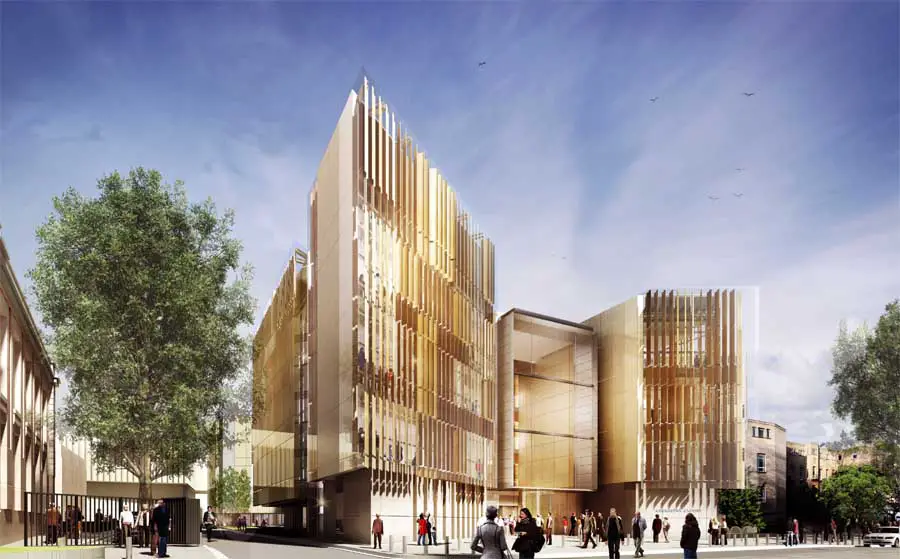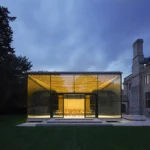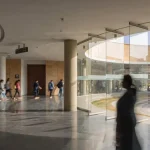Chemistry Oxford Building, Chemistry Laboratory Project UK, fjmt Design Image
Chemistry Oxford Building: Laboratory
Laboratory Complex Development in England design by Francis- Jones Morehen Thorp Architects
26 Jul 2011
Chemistry Oxford Laboratory Complex
Design: Francis- Jones Morehen Thorp (fjmt)
CHEMISTRY OXFORD PROJECT RECEIVES PLANNING PERMISSION UNIVERSITY OF OXFORD, UNITED KINGDOM
The University of Oxford has received planning permission for a new £170M chemistry laboratory complex designed by Francis- Jones Morehen Thorp (fjmt). This follows a unanimous vote in favour of the scheme by Oxford City Council’s West Area Planning Committee where the scheme was described as one of the most striking new buildings in Oxford.
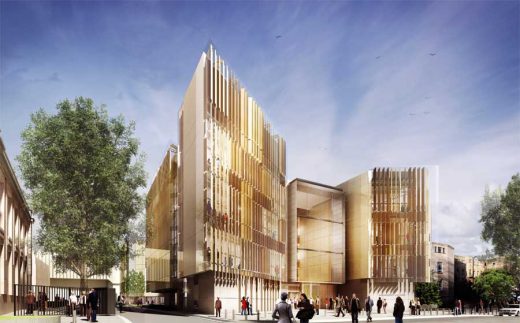
image from Francis- Jones Morehen Thorp (fjmt)
Known as Chemistry Oxford, the project will both augment the existing Chemistry Research Laboratory in the University’s Science Area and bring together researchers currently distributed across four different buildings. An additional 20,000sq m of flexible floor space will be created providing facilities that will meet the requirements of 21st century scientific research and allow the Department’s scientists to tackle many of the most important problems facing mankind today from medicine to energy and climate.
The proposed design presents a dynamic assembly of architectural forms that open dramatically to Mansfield and South Parks Roads, creating an exciting and memorable identity for the Department in this highly visible location.
The most prominent facade system is made up of automated shaped timber louvres set within a highly transparent glazed and ventilated cavity. This double skin system provides the new building with a rich vertically grained material quality that is intended to complement the colour, scale and texture of some of Oxford’s finest heritage architecture. The louvres allow occupant control of natural light and views and afford the option for natural ventilation and mixed-mode operation for workplace areas.
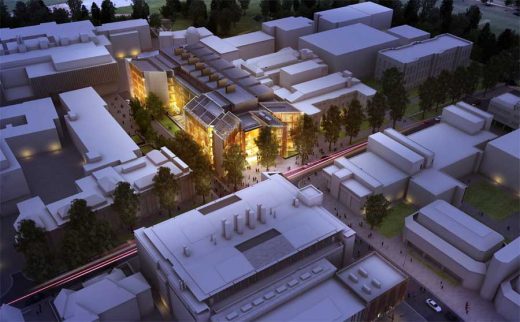
image from Francis- Jones Morehen Thorp (fjmt)
A new series of landscaped open spaces will create an enhanced context for the new building. In the tradition of Oxford’s great institutions and their related open spaces, this ‘Chemistry Green’ concept will enrich the surrounding public domain and further represent Chemistry’s presence in the Science Area.
The new building will form an architectural benchmark for Chemistry and the wider Science Area. It will house over 80 new research laboratories as well as analytical, technological and support facilities, providing space for a diverse range of research groups. State-of-the art teaching laboratories and lecture theatres are also provided. The new facility will be physically connected to the existing Chemistry Research Laboratory by an underground ‘street’. This light-filled spine will create a strong connection between the two facilities improving physical, functional and social linkages, and maximising the efficient use of space across the site.
The new Oxford Chemistry facility aims to be the ‘greenest’ Chemistry laboratory in the world and is currently targeting a minimum BREEAM ‘Excellent’ rating but with aspirations to achieve “Outstanding” once completed. In addition the new building will also be designed to have the lowest possible energy use for a building of this type and is currently targeting between 20 – 50% lower than the existing Chemistry Research Laboratory.
The planning approval is timely, coming as it does in the UNESCO International Year of Chemistry, a celebration of Chemistry’s “essential contributions to knowledge, to environmental protection and to economic development.”
Chemistry Oxford Building – Background
The Department of Chemistry at the University of Oxford is proud to be one of the leading university chemistry departments in the world. With 17 active fellows of the Royal Society, and listing among its alumni some nine Nobel laureates, the Department has played a key role in shaping the modern world, with contributions ranging from the lithium battery, to DNA technology.
However, the Department presently operates from several buildings constructed primarily between 1916 and 1959 and, sadly, no longer suitable for modern day science. The unique undergraduate course, judged excellent by HEFCE, is the best in the United Kingdom and with the new building will now be delivered in accommodation of comparable quality.
The proposed site is key as with some of the most exciting science occurring at the interface between subjects, the location will allow the Department to act as a collaborative facility and to be linked intellectually, physically and visually to the rest of the Science Area.
The Department’s significant contribution to regional economic development is witnessed by the commercialisation of its research in the form of 13 spin-off companies, many now established on local science parks around Oxford. Generating some two billion pounds in wealth to date, this proposed building will allow the Department to continue at the cutting edge of invention and company foundation.
In addition to the above the Department enthusiastically engages schools and the wider community, regularly hosting lively visits and events within the Department, and participating in activities to inspire the next generation of chemists by demonstrating chemistry’s central role in everyday life. The facilities for teaching, breakout and interaction provided in the new building will serve these activities admirably.
This exciting, functional, and flexible building will help ensure the Department’s continued viability and success, delivering the research and teaching needs of the department now, and in the future.
Chemistry Oxford images / information from Francis- Jones Morehen Thorp
Location: South Parks Road, Oxford, England, UK
Oxford Architecture
Oxford Architecture Designs – chronological list
Oxford Architecture – Science Building Selection
Oxford Molecular Pathology Institute Building
Make with Nightingale Associates
Oxford Molecular Pathology Institute
Oxford Science & Enterprise Centre
Foster + Partners
Oxford Science & Enterprise Centre
Middle East Centre, St. Antony’s College
Zaha Hadid Architects
University of Oxford Building
University College Boathouse
Belsize Architects
University College Boathouse
Comments / photos for the Chemistry Oxford Building design by Francis- Jones Morehen Thorp Architects page welcome

